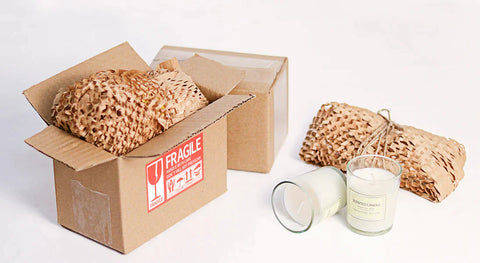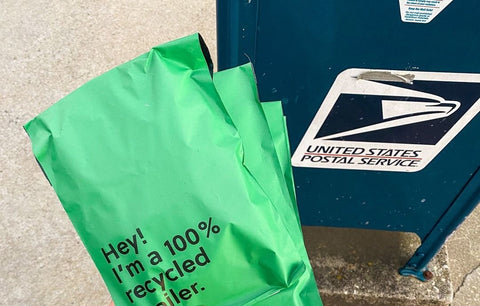Sustainable Packaging Solutions for Small Businesses

As the global economy grows and e-commerce continues to rise, the impact of packaging on the environment has become a significant concern. Today's consumers are more aware than ever before of the environmental footprint of their purchases, including the packaging that shields their goods. This awareness has spurred a trend toward a sustainable packaging movement that is not just admired but increasingly expected by customers.
What is sustainable packaging?
Sustainable packaging is a form of packaging that is designed to have minimal environmental impact and a reduced carbon footprint throughout its life cycle. This type of packaging aims to be resource-efficient, recyclable, biodegradable, and often made from renewable sources. Key features of sustainable packaging include:
- Recyclability: The ability to be recycled into new products after its initial use, thus reducing the need for virgin material and minimizing waste in landfills.
- Biodegradability: Materials that can break down naturally over time without leaving harmful residues or toxins in the compostable environment.
- Renewable Materials: Packaging made from materials that are sourced from renewable resources, such as plants, which can be regrown sustainably over time with limited recyclability.
- Low Environmental Impact Production: Manufacturing processes that require less energy and water, produce fewer emissions, and do not release toxic substances into the environment.
- Reduced Packaging Content: Using the least amount of material necessary to safely package a product, thereby minimizing waste and material usage.
- Efficiency in Logistics: Space-efficient design leads to lower emissions and reduced energy consumption during shipping, optimizing transportation and storage.
Why do we need sustainable packaging?
The importance of sustainable packaging can’t be understated. According to the data from statista.com, the worldwide production of plastics reached a staggering 400.3 million metric tons in 2022. In 2021, around 80 to 84 percent of plastic waste in the United States was estimated to be sent to landfills.
Not only does sustainable packaging help to preserve natural resources and reduce pollution, but it also aligns with a growing consumer demand for environmentally responsible products. Businesses that adopt sustainable practices often find cost benefits in the long term through reduced material use and enhanced brand image.
Furthermore, the pursuit of sustainable packaging aligns perfectly with the theme of World Earth Day, which takes place on April 22nd. In 2024, the theme is "Planet vs Plastic," emphasizing the global initiative to reduce plastic pollution and advocate for environmental stewardship.
Solutions For Sustainable Packaging
Choose Sustainable Materials
Several materials are considered sustainable due to their environmental benefits. Here are some examples:
- Paper and Cardboard: Sourced from managed forests where trees are replanted to ensure sustainability. These materials are widely recyclable and biodegradable.
- Recycled Plastics: Using recycled plastics reduces the need for virgin plastic production, which consumes fossil fuels. It also keeps plastic waste out of landfills and oceans.
- Plant-Based Plastics (Bioplastics): These plastics are made from renewable resources like corn starch, sugarcane, or cellulose. Some bioplastics are biodegradable or compostable under certain conditions.
- Mushroom Packaging (Mycelium): This is a packaging material made from the root structure of fungi. It's grown into molds to form custom shapes and is biodegradable and compostable.
- Organic Cotton: Grown without harmful pesticides and synthetic fertilizers, organic cotton has less environmental impact than conventional cotton and can be used for clothing, bags, and other fabric-based items.
- Wool: A natural fiber that is renewable and biodegradable. Wool can be used for insulation, clothing, and other textile applications.
- Glass: While it requires considerable energy to produce, glass is infinitely recyclable without loss of quality, making it a sustainable option if recycled properly.

Reduce Packaging Size and Weight
Evaluate your packaging process and minimize the material used without compromising product protection. Smaller and lighter packaging uses fewer materials, which can lead to a reduction in the depletion of natural resources. It also decreases the carbon footprint associated with the production, transportation, and disposal of packaging, resulting in cost savings in terms of materials.
Furthermore, by minimizing the size and weight of packaging, brands can enhance their image by showcasing a dedication to sustainable practices and environmental stewardship, aligning with contemporary values of responsible development.
Utilize Intelligent Packaging
Integrate advanced technological innovations and imaginative designs into packaging solutions that not only offer reusability but also multi-functionality.
By embedding QR codes, customers can easily access detailed information regarding the recyclability of products, thus enhancing the product's sustainability profile and encouraging environmentally responsible behavior.
Support Sustainable Partnerships
Partner with packaging suppliers and local distributors who also value sustainable practices. This includes choosing carriers that offer eco-friendly shipping options, such as UPS and USPS.

Collaborations focused on sustainability reinforce the commitment to environmental protection, encouraging practices that reduce waste, conserve resources, and mitigate negative impacts on ecosystems.
Sustainable Packaging Examples
Customization For Fragile Products
Sustainable packaging for fragile products involves using environmentally friendly materials and innovative design approaches that provide adequate protection while minimizing environmental impact.
Use recycled or biodegradable materials such as honeycomb packing paper to replace plastic bubble wrap or foam peanuts to reduce waste, consume fewer resources, and lower pollution, helping to preserve ecosystems and biodiversity.
SEE ALSO: Honeycomb Paper vs Bubble Wrap: Which is Better?

Delivery of Packaging
Shipping labels are necessary in transit to indicate detailed product information.
Sustainable shipping labels, which have passed the Forest Stewardship Council (FSC) certification play an important role in reducing the environmental impact of the shipping and logistics industry. Designed with eco-friendliness as a priority, these labels aim to reduce waste and pollution across the product's entire life cycle.
Sealing the Box
A strong adhesive tape is crucial for sealing boxes securely. Despite the adhesion when choosing a tape, the sustainability of the material should be taken into consideration.
Certified as climate-friendly, the Kraft paper tape is crafted from natural Kraft paper, making it a more eco-friendly option than its plastic counterparts. Choosing to use a compact, recyclable box sealed with paper tape can substantially reduce costs and decrease waste.

SEE ALSO: Choosing Packing Tape: Plastic or Paper?
Clothing Packaging
Sustainable shipping bags, especially used in the clothing industry, are intended to minimize environmental impact, offering a more ecologically responsible option for companies and consumers concerned about sustainability.
Tips For Green Packaging Practices
- Assess Current Packaging: Review your current packaging solutions to understand the materials used, waste generated, and overall environmental footprint.
- Consider the Cost: Eco-friendly materials can sometimes be more expensive than conventional ones due to lower supply or higher production costs. However, prices may decrease as demand grows and production scales up.
- Test and Iterate: Pilot new packaging solutions with a subset of products to gauge performance and customer response. Adjust designs based on feedback and results to continuously improve sustainability.
- Foster Partnerships: Collaborate with other businesses, non-profit organizations, and industry groups to share best practices and advocate for systemic changes in packaging waste management.
At the same time, media publicity can help shape an enterprise's image of sustainability. Communicating its use of eco-friendly packaging increases public awareness of the company's responsible behavior, thereby improving the brand's favorability and reputation.
Wrap Up
Sustainable packaging is more than a trend; it's a crucial component of a forward-thinking business strategy. By adopting these solutions, small businesses can contribute to a healthier planet, satisfy customer expectations, and potentially realize cost savings.
The future shines bright for companies that integrate sustainability into their core operations, with innovations continuously emerging to improve both the efficacy and environmental footprint of packaging. In taking these steps, small businesses not only make a positive impact on the world today but also invest in their own resilient and prosperous future.

